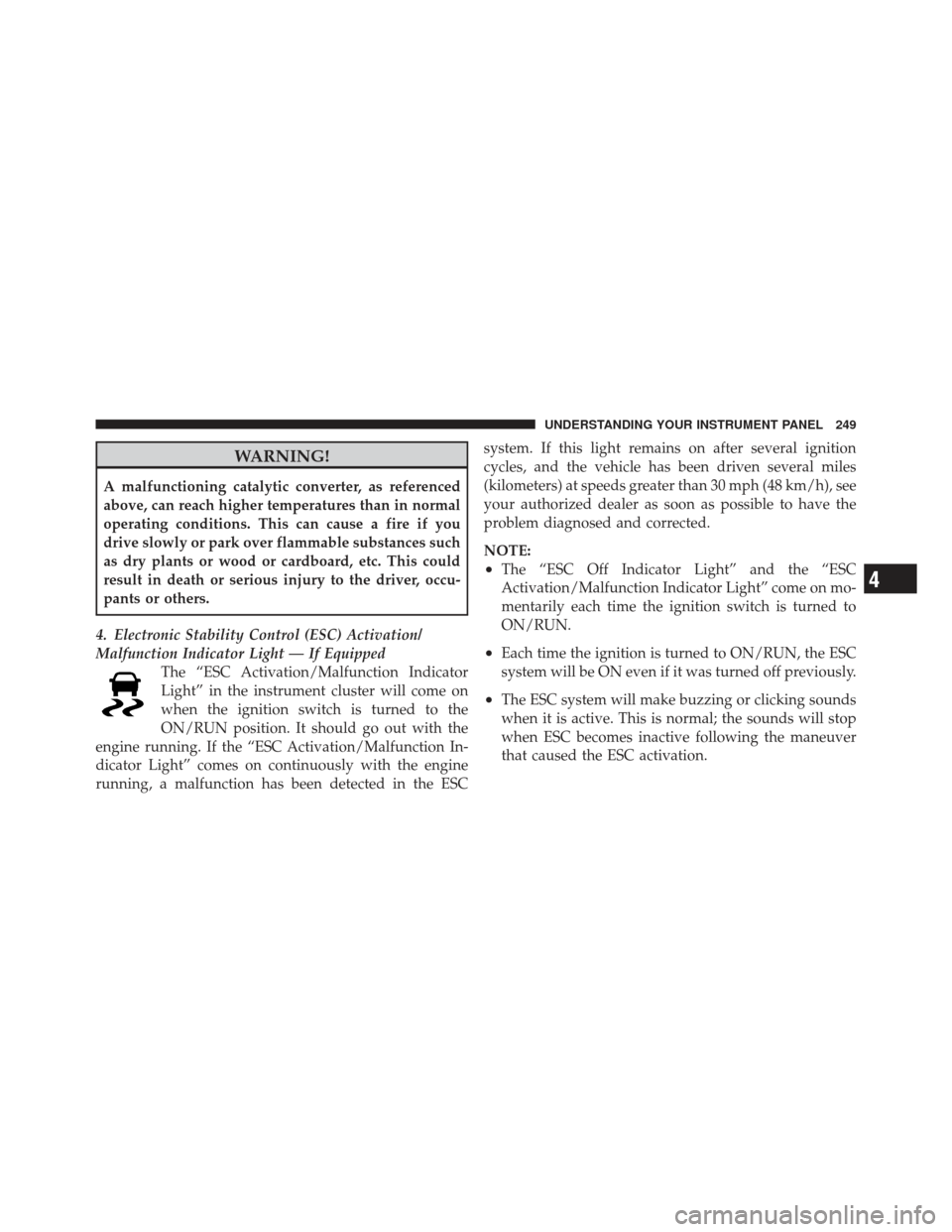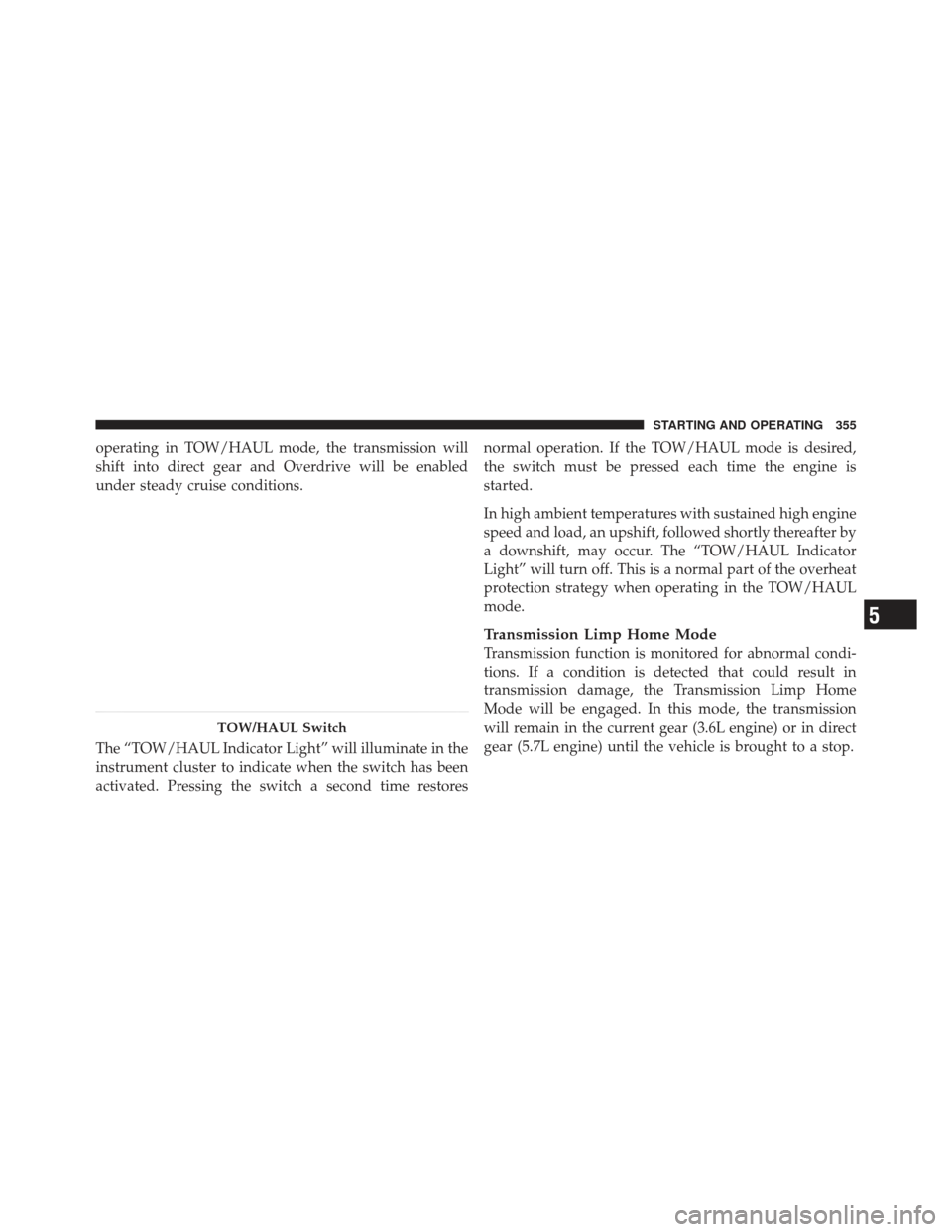Page 204 of 587

•Clean the ParkSense�sensors regularly, taking care
not to scratch or damage them. The sensors must not
be covered with ice, snow, slush, mud, dirt or debris.
Failure to do so can result in the system not working
properly. The ParkSense� system might not detect an
obstacle behind the fascia/bumper, or it could provide
a false indication that an obstacle is behind the fascia/
bumper.
•Objects such as bicycle carriers, trailer hitches, etc.,
must not be placed within 12 in (30 cm) from the rear
fascia/bumper while driving the vehicle. Failure to do
so can result in the system misinterpreting a close
object as a sensor problem, causing the “SERVICE
PARK ASSIST SYSTEM” message to be displayed in
the instrument cluster.
•On vehicles equipped with a tailgate, ParkSense �
should be disabled when the tailgate is in the lowered or open position and the vehicle is in REVERSE. A
lowered tailgate could provide a false indication that
an obstacle is behind the vehicle.
CAUTION!
•ParkSense�
is only a parking aid and it is unable
to recognize every obstacle, including small ob-
stacles. Parking curbs might be temporarily de-
tected or not detected at all. Obstacles located
above or below the sensors will not be detected
when they are in close proximity.
•The vehicle must be driven slowly when using
ParkSense� in order to be able to stop in time
when an obstacle is detected. It is recommended
that the driver looks over his/her shoulder when
using ParkSense�.
202 UNDERSTANDING THE FEATURES OF YOUR VEHICLE
Page 245 of 587
UNDERSTANDING YOUR INSTRUMENT PANEL
CONTENTS
�Instrument Panel Features ............... 246
� Instrument Cluster .................... 247
� Instrument Cluster Descriptions ........... 248
� Electronic Vehicle Information Center (EVIC) . . 258
▫ Electronic Vehicle Information Center (EVIC)
Displays ........................... 260
▫ EVIC White Telltale Lights .............. 266
▫ EVIC Amber Telltale Lights ............. 267
▫ EVIC Red Telltale Lights ............... 269 ▫
Engine Oil Change Indicator System ....... 272
▫ Fuel Economy ...................... 272
▫ Vehicle Speed ....................... 274
▫ Trip Info .......................... 274
▫ Units ............................. 275
▫ Vehicle Info
(Customer Information Features) ......... 276
▫ TirePsi ........................... 276
▫ Keyless Enter-N-Go Display —
If Equipped ........................ 277
4
Page 248 of 587
INSTRUMENT PANEL FEATURES
1 — Air Outlet6 — Lower Switch Bank11 — Hood Release
2 — Instrument Cluster 7 — Hazard Switch12 — Fuel Door Release
3 — Radio 8 — Storage Bin13 — Headlight Switch
4 — Glove Compartment 9 — ESC Button14 – Dimmer Control
5 — Climate Controls 10 — Ignition Switch
246 UNDERSTANDING YOUR INSTRUMENT PANEL
Page 249 of 587
INSTRUMENT CLUSTER
4
UNDERSTANDING YOUR INSTRUMENT PANEL 247
Page 250 of 587

INSTRUMENT CLUSTER DESCRIPTIONS
1. Tachometer
Indicates the engine speed in revolutions per minute
(RPM x 1000).
2. Airbag Warning LightThis light will turn on for four to eight seconds
as a bulb check when the ignition switch is first
turned to the ON/RUN position. If the light is
either not on during starting, stays on, or turns
on while driving, then have the system inspected at an
authorized dealer as soon as possible. Refer to “Occupant
Restraints” in “Things To Know Before Starting Your
Vehicle” for further information.
3. Malfunction Indicator Light (MIL) The Malfunction Indicator Light (MIL) is part of
an onboard diagnostic system called OBD II that
monitors engine and automatic transmission con-
trol systems. The light will illuminate when the key is in the ON/RUN position before engine start. If the bulb
does not come on when turning the key from OFF to
ON/RUN, have the condition checked promptly.
Certain conditions such as a loose or missing gas cap,
poor fuel quality, etc., may illuminate the light after
engine start. The vehicle should be serviced if the light
stays on through several of your typical driving cycles. In
most situations, the vehicle will drive normally and will
not require towing.
CAUTION!
Prolonged driving with the MIL on could cause
damage to the engine control system. It also could
affect fuel economy and drivability. If the MIL is
flashing, severe catalytic converter damage and
power loss will soon occur. Immediate service is
required.
248 UNDERSTANDING YOUR INSTRUMENT PANEL
Page 251 of 587

WARNING!
A malfunctioning catalytic converter, as referenced
above, can reach higher temperatures than in normal
operating conditions. This can cause a fire if you
drive slowly or park over flammable substances such
as dry plants or wood or cardboard, etc. This could
result in death or serious injury to the driver, occu-
pants or others.
4. Electronic Stability Control (ESC) Activation/
Malfunction Indicator Light — If Equipped The “ESC Activation/Malfunction Indicator
Light” in the instrument cluster will come on
when the ignition switch is turned to the
ON/RUN position. It should go out with the
engine running. If the “ESC Activation/Malfunction In-
dicator Light” comes on continuously with the engine
running, a malfunction has been detected in the ESC system. If this light remains on after several ignition
cycles, and the vehicle has been driven several miles
(kilometers) at speeds greater than 30 mph (48 km/h), see
your authorized dealer as soon as possible to have the
problem diagnosed and corrected.
NOTE:
•The “ESC Off Indicator Light” and the “ESC
Activation/Malfunction Indicator Light” come on mo-
mentarily each time the ignition switch is turned to
ON/RUN.
•Each time the ignition is turned to ON/RUN, the ESC
system will be ON even if it was turned off previously.
•The ESC system will make buzzing or clicking sounds
when it is active. This is normal; the sounds will stop
when ESC becomes inactive following the maneuver
that caused the ESC activation.
4
UNDERSTANDING YOUR INSTRUMENT PANEL 249
Page 260 of 587
ELECTRONIC VEHICLE INFORMATION CENTER
(EVIC)
The Electronic Vehicle Information Center (EVIC) fea-
tures a driver-interactive display that is located in the
instrument cluster.The EVIC consists of the following:•System Status
•Vehicle Information Warning Message Displays
•Personal Settings (Customer-Programmable Features)
•Compass Display
•Outside Temperature Display
•Trip Computer Functions
Electronic Vehicle Information Center (EVIC) Display
258 UNDERSTANDING YOUR INSTRUMENT PANEL
Page 357 of 587

operating in TOW/HAUL mode, the transmission will
shift into direct gear and Overdrive will be enabled
under steady cruise conditions.
The “TOW/HAUL Indicator Light” will illuminate in the
instrument cluster to indicate when the switch has been
activated. Pressing the switch a second time restoresnormal operation. If the TOW/HAUL mode is desired,
the switch must be pressed each time the engine is
started.
In high ambient temperatures with sustained high engine
speed and load, an upshift, followed shortly thereafter by
a downshift, may occur. The “TOW/HAUL Indicator
Light” will turn off. This is a normal part of the overheat
protection strategy when operating in the TOW/HAUL
mode.
Transmission Limp Home Mode
Transmission function is monitored for abnormal condi-
tions. If a condition is detected that could result in
transmission damage, the Transmission Limp Home
Mode will be engaged. In this mode, the transmission
will remain in the current gear (3.6L engine) or in direct
gear (5.7L engine) until the vehicle is brought to a stop.
TOW/HAUL Switch
5
STARTING AND OPERATING 355